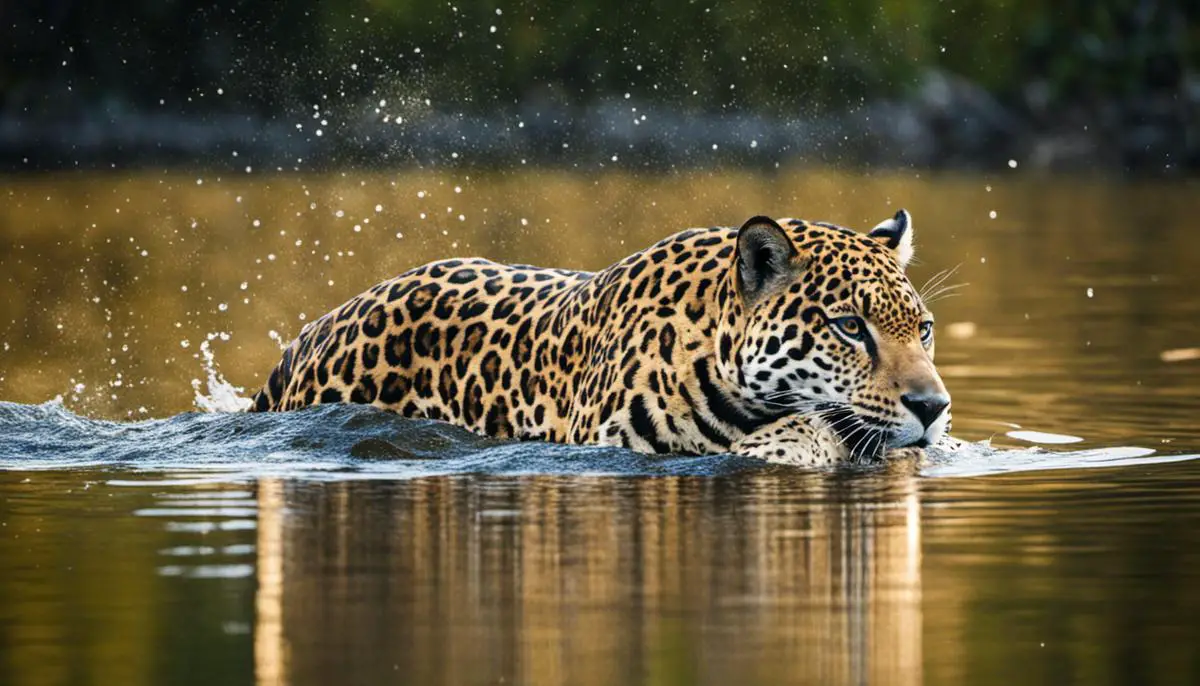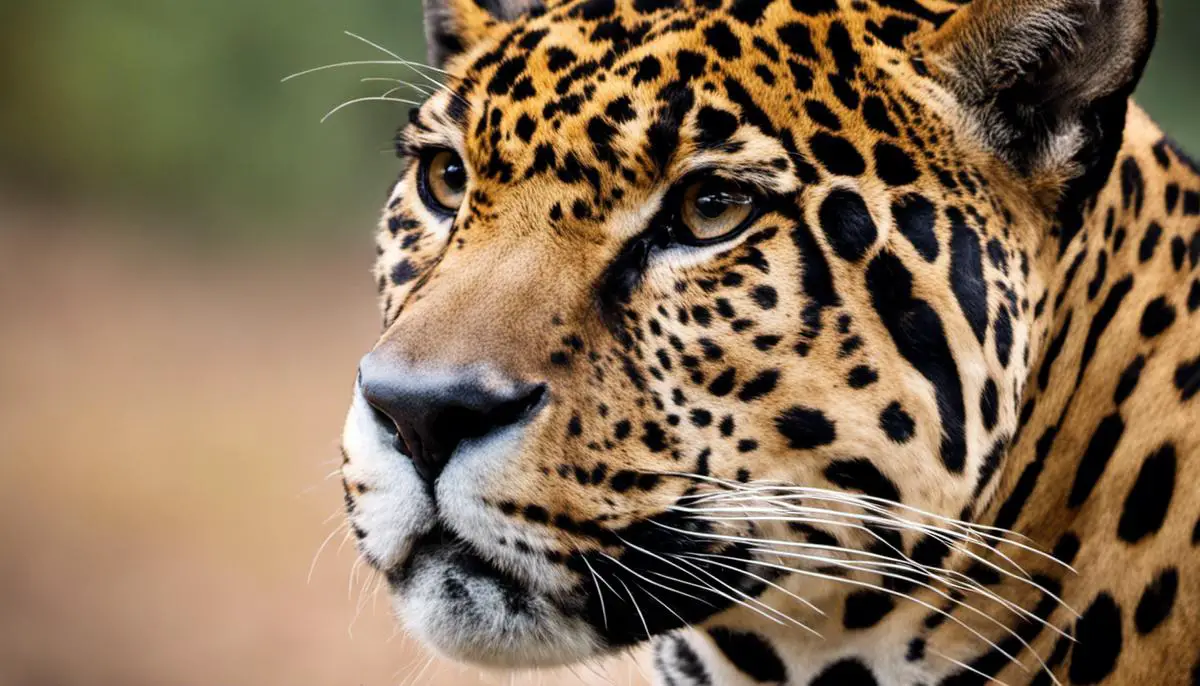A Profound Examination of the Aquatic Affinities of Jaguars
Do Jaguars like water? Jaguars (Panthera onca) are known to be proficient swimmers and are generally comfortable in water. They are often observed crossing rivers and streams in their natural habitat. While they are not considered aquatic animals like some species of big cats, such as tigers, which are known for their affinity for water, jaguars do not shy away from it and can swim when necessary. Their ability to swim allows them to access different areas of their territory and pursue prey that may be near or in the water.
Standing as a magnificent testament to evolution’s whims, the jaguar embodies a fascinating departure from the typically hydrophobic nature of large feline species. Adorned in its iconic rosette-studded coat, it rules not only the dense foliage of its terrestrial territories but also the watery realms, demonstrating an uncanny affinity for aqueous environments.
This introductory exploration dives into the complex world of Jaguars and their atypical hydrophilic behaviours, dissecting elements such as their unique water preferences, deft swimming abilities, and dietary peculiarities. Also, it unfolds a comprehensive comparison between the jaguar’s behavioural patterns and that of other large cats, shedding light on its surprisingly aquatic disposition.
Jaguars and their Hydrophilic Behaviours
Research observations have indeed demonstrated that jaguars display a striking affinity for water, rather distinct from the typical behaviour demonstrated by other large felines. Whereas most big cats tend to shy away from water, the Jaguar (Panthera onca) is known to swim proficiently, often using bodies of water such as rivers and swamps as part of its habitat. This departure from normative aversion towards water seen in the cat family can be attributed to the evolutionary adaptations the jaguar has developed in relation to its environment – largely the tropical, sub-tropical, and wetland regions of Central and South America.
Several reasons for this behavioural divergence can be postulated. Notably, the utilization of aquatic environments provides the jaguar with additional hunting opportunities. This species is observed catching fish, turtles, and caiman – a small alligator species – from the water, showcasing its adaptability and versatility in prey selection.
Another plausible explanation lies in the scarcity of competitors that could challenge the jaguar’s dominion in the water. These environmental adaptations provide the jaguar with a unique niche, relative to other large cats, that optimizes survival and reproductive success.
Interestingly, this prominent feature does not exist as an isolated phenomenon, but rather as a link in a chain of complex adaptations. The jaguar possesses a muscular build and shorter limbs, enabling powerful strokes whilst swimming. Moreover, its coat of compact rosettes serves as an optimum camouflage in dappled light conditions, thus facilitating effective stealth and ambush strategies in riparian environments. Thus, the affinity for water demonstrated by Jaguars cannot be separated from the contextual tapestry of evolutionary, anatomical, and behavioural adaptations that define this intriguing species.

Ecological Significance of Jaguars’ Attraction to Water
The hydrophilic tendency of Panthera onca, or as they are most commonly known, jaguars, extends their habitat and food accessibility. Their profound inclination for water-enriched environments diverges notably from the behavioural traits observed in other members of the Panthera genus. From an ecological perspective, this attraction to water facilitates a wider prey base. Nevertheless, they exhibit a preference for semi-aquatic animals such as caimans and turtles, exemplifying specific behavioural adaptation in the jaguar environs.
Moreover, this hydrophilic nature has cultivated adaptive traits within the species that are singularly conducive to life within water-abundant ecosystems. The distinctive layering within the coat of jaguars is a testament to this fact. Covering their muscular build, the jaguar’s coat is comprised of two main layers: an outer layer that is coarse, serving a waterproof function, and an under-layer that is fine, providing an insulating barrier to maintain body temperature in aquatic environments.
In a consequence to these characteristics, jaguars have moulded their role within their ecological habitat. Often reverting to nocturnal activity, they exploit the concealment provided by waterways under the shroud of darkness. The distinct rosette pattern on their fur facilitating camouflage in the undergrowth further aids this. This proclivity towards aquatic environments combined with their solitary nature, results in a markedly different ecological impact compared to land-based felines.

Conservation and Jaguar-Water Relationship
Highlighting the unique aquatic proclivity of jaguars underscores the importance of healthy water systems in their conservation efforts. As these magnificent creatures embody a specifically evolved role in aquatic ecosystems, a decline in water quality or access can have dire repercussions on their survival.
Beyond mere survival, access to healthy water systems is essential to the jaguar’s courtship, mating, and rearing of young, as it offers indispensable seclusion from other predators. Therefore, insisting on high-priority status for water conservation in global and local environmental policies indeed translates into maintaining the survival and propagation of jaguar populations.
Unveiling the ties between jaguars and their aquatic terrains also advocates for the conservation of biodiversity in these regions. The jaguars’ presence, being apex predators, governs the population dynamics in these ecosystems, maintaining a balanced food web. Hence, ensuring sustenance for jaguars could guarantee the preservation of entire ecosystems.
Examining and elucidating the relationship between jaguars’ nocturnal activity and their affinity for water can provide key insights into their behavioural patterns. Their ability to negotiate aquatic terrains during the darkness of night exhibits a remarkable manifestation of evolutionary prowess and is singular to this species. This facet, therefore, magnifies the importance of low-light environments as crucial to their survival and dispersal.
Illustrating the interaction between jaguars and their aquatic environments underscores their critical role in their habitat. Their predation creates a balance, controlling the population of other creatures and maintaining the health of the ecosystem. Consequently, it confirms their indispensability in these habitats.
Therefore, acknowledging the singular bond between jaguars and their aquatic ecosystems could contribute to more effective and tailored conservation management strategies, ultimately enhancing their survival odds while promoting biodiversity within these unique habitats.

Throughout its existence, the Jaguar has ingeniously used its aquatic propensities to its advantage, securing its reign at the apex of the food chain and achieving an evolutionary edge. The unique nature of this species, as it enthusiastically engages with water, profoundly impacts its daily routine, dietary configuration, and breeding rituals.
Simultaneously, it plays a pivotal role in its ecological niches and in the conservation strategies adopted to ensure its survival. These carefully interwoven threads shed light on Jaguar’s captivating fondness for water, illuminating the silent narrative of one of the world’s most tantalizing predators.
Hence, this exploration serves as a testament to the Jaguar’s unique skills and the intricate elements of survival in the ever-thriving realm of the animal kingdom.
